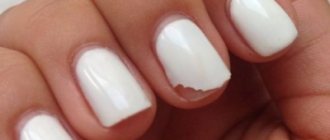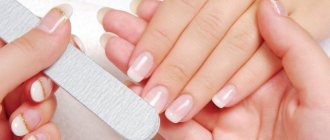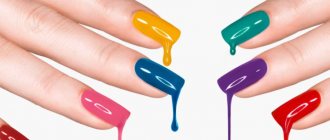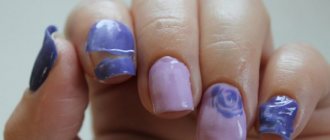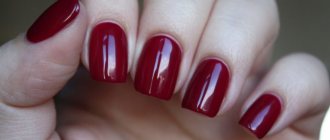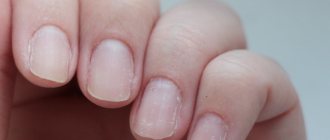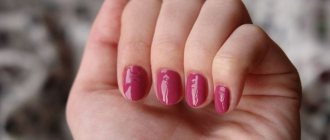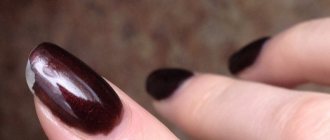Gel polish quickly peels off from the nail for several reasons: due to the fault of the master (process technology is violated, low-quality materials are used), due to the fault of the “owner” of the decorative coating (mechanical impact, shock, violation of care rules) and due to natural factors (diabetes, pregnancy, applying gel polish during the current period, taking antibiotics).
By removing provoking factors and following precise manicure technology, you can prevent peeling of the decorative coating.
There are several ways to correct the resulting flaws: completely change the gel polish, use decorations such as rhinestones, stickers, or disguise a small chip with varnish of a similar or contrasting color. The manicure will no longer be flawless, but the problem area will be hidden from others.
Why does gel polish peel off quickly from the nail: the main reasons
The reasons for the rapid peeling of gel polish from the nail may be the technician’s mistakes when performing the work and ignoring the rules for caring for the decorative coating by the girl/woman herself.
| Reasons due to the fault of the master | It's the girl's fault |
| Use of low quality materials or different manufacturers in the work | Prolonged contact with water in the first few hours after a manicure with gel polish |
| Violation of process technology - for example, improper processing of the cuticle, applying a base to the cuticle, poor degreasing of the surface, and so on | Carrying out spa treatments for hands immediately before applying gel polish: oils and steaming provide excessive moisture and increased oiliness of the nail plate |
| Applying too thick a layer of gel polish or base in the area of the anatomical location of the cuticle | Applying a decorative coating to nails that are too thin or peeling plates |
| Failure to comply with the time period required to dry each layer of materials in the lamp | Ignoring the warning that gel polish does not last when applied during menstruation |
| Ignoring the need to remove the sticky top layer | Excessively oily skin of the hands/fingers, which has not been treated beforehand - for example, oak bark decoction baths have not been taken |
In addition to the listed reasons for the rapid detachment of gel polish, it is worth paying attention to the general health of the woman: some internal pathologies provoke the occurrence of this problem even if the master performs his work strictly according to technology and using high-quality materials.
There is no need to hope for the promised result after a manicure with gel polish if the client has a history of diabetes, heart and vascular diseases, various hormonal disorders, or the woman is taking antibacterial drugs as part of the therapy.
We recommend reading the article about the difference between gel polish and shellac. From it you will learn what is the difference between gel polish and shellac, what is better and what is more harmful, and also how to extend the wearing period. And here is more information about how to do a French manicure with gel polish.
Gel polish chips and peels off sooner than after 2 weeks of wear.
The most likely reason that the gel polish does not hold well, swells, chips and detachments appear is a defect in the manicure: improper preparation of the nail, violation of the sequence of steps, neglect of any of them, or insufficiently thorough execution. The quality of gel polish is at the very last place.
Chips and detachments of gel polish most often occur due to:
- There is a pterygium left somewhere in the cuticle area.
- A dehydrator was not used, so natural oil components remained on the surface of the nail plate. The dehydrator should also be passed along the ends and on the inside of the free edge of the nail.
- When applying the base, you need to leave a small indentation from the cuticle, otherwise it will not be correct.
- The base is applied too thick.
- Abundant sealing of the nail end with all layers of coating. As a result, a critical mass accumulates and adhesion to the end is disrupted, microcracks appear. You need to be extremely subtle, just the base, finish and once with color.
- If the length is long, the overgrown free edge often bends, even imperceptibly - the integrity of the varnish is compromised in stress areas on the sides; gel polish does not last long on long nails.
Also, chips and detachments of gel polish quickly appear if there is a lot of prolonged contact with water - washing, washing dishes without rubber gloves. Sooner or later the gel polish will swell, because... The nail heats up in water, absorbs moisture, becomes softer and more elastic, and is easier to bend. This results in overtension in the layers, as a result - microcracks that violate the tightness of the coating, and then chipping or peeling is a matter of time.
Good news. Chips of gel polish along the edges and corners of the nail can be eliminated using restoration, similar to the correction of overgrown gel polish . They often ask whether it is necessary to remove the stickiness from the base sublayer; supposedly, this technique is taught in some courses and is found in video materials. Overall, this is wrong. The dispersion layer is the residual stickiness of the gel component, formed after polymerization of the substance under the influence of ultraviolet radiation. Polymerization is the attachment of small molecules of gel polish to each other, as a result of which large, rigid molecular structures are formed (the varnish hardens), and those that are not attached are pushed to the surface (they will react with the next layer). This creates a sticky layer; if it is removed at the stage of the base or intermediate color stains, the adhesion will deteriorate and the wearability of the coating will decrease. Another thing is that gel polish is such a universal substance that it will still last quite a long time. Therefore, we must proceed from expediency - it is permissible to remove the stickiness for the sake of completing the design, or if you are just learning how to apply gel polish and do not have time to paint the nail, the varnish spreads.
Why gel polish doesn’t stay on nails due to the master’s fault
Gel polish on nails most often does not stay on due to the fault of the master, although the process of performing a manicure does not present any particular difficulties, and the main reasons for the decorative coating coming off are the following violations of the technological process:
- there are remnants of microparticles of fat on the nail plate and adjacent areas;
- The base varnish is applied in too thick a layer, or its polymerization has not been fully completed (insufficient drying in the lamp);
- the free base of the nail was not sealed;
- poor quality preparation – the pterygium layer has not been removed from the plate near the cuticle;
- one of the layers (or all at once) is not dried well enough;
- The topmost layer of fixative (top) is not applied to the entire surface of the nail or lies unevenly.
Another common mistake of the master is that he uses varnishes from different ones due to different composition. Professionals recommend using base, primer, gel polish and top coat of the same brand.
Why do nails streak?
Gel polish can streak the nails and lie unevenly on the plate, and there are several reasons for this:
- the decorative coating has expired;
- loss of textural uniformity of gel polish;
- unevenness of the nail plate;
- not removing the sticky layer from the base.
It should be taken into account that any unevenness on the surface of the nail (grooves, roughness, tubercles) will be clearly visible even after applying gel polish - the coating completely repeats the relief of the plate, which leads to the appearance of stripes and uneven painting.
There are several options to solve the problem:
- It is worth preparing an ideal base for a colored coating, and this can be done using rubber material;
- before applying gel polish, gently roll the bottle with it in your palms - perhaps the pigment has simply settled, and shaking will solve the problem;
- remove the sticky layer from the base and dry the treated surface well;
- Apply both the decorative coating and the base in the thinnest possible layers and make 2 of them, thoroughly drying each in a lamp;
- apply gel polish with a drop, and then stretch it parallel to the nail (this is how you need to hold the brush).
Why did it become soft
Gel polish becomes soft even if the master fully complies with the technological process, and the reasons for this problem may be:
- weak/poor quality lamp - you should try to dry each layer of coating longer and carefully monitor the level of polymerization or change the bulbs/spirals/diodes to new ones;
- unsuitable lamp for gel polish - some brands produce coatings designed for drying only in “their” lamps;
- gel polish was applied, which is dried only in LED lamps, and the master uses a different type of lighting equipment.
The most common reason for the softness of a decorative coating is the expiration date of the material, but often there is a defect from the manufacturer.
Why does it flake?
Gel polish can begin to flake off literally in the first day after a manicure, and this problem is considered the most common, and its causes can be classic violations on the part of both the master and the girl/woman:
- the pterygium (a thin layer of skin on the nail near the cuticle) was poorly removed;
- the nail and the entire area around it were poorly degreased;
- the base, gel polish and top coat were applied in too thick layers and, as a result, did not fully polymerize;
- the top coat is applied unevenly;
- immediately after the manicure, the nails are in water;
- when working with any aggressive liquids, the girl/woman does not use gloves;
- manicure was applied during menstruation, pregnancy or in the acute phase of hormonal disorders.
To prevent gel polish from peeling off, you should remember three “don’ts”:
- the day before you cannot perform spa treatments or do oil manicures;
- in the first 10 hours, you should avoid prolonged dishwashing, hand washing and general cleaning;
- Using detergents, cleaners and any other aggressive liquids without gloves can cause the decorative coating to peel off.
Why does acrygel come off from nails?
Acrigel may come off from nails for the following reasons:
- during the preparation of the natural plate, the master cleaned the pterygium poorly;
- Initially, the cuticle was removed using a softener, and its particles remained on the nail;
- acrygel is placed too close to the cuticle and lateral skin ridges;
- the material is too liquid or too dry;
- Old ultraviolet lamps are used to dry the coating, but they do not polymerize the coating properly.
Also, acrygel can come off the nails if it is applied to a plate that is too long - the pressure on the tips of the nails increases, and the decorative layer begins to “spring.” In this case, the detachment of the material begins from the sides or directly at the cuticle itself.
When and how can you save your manicure?
If a piece of gel polish breaks off on the side, it’s not a problem. You should not immediately blame the master and call him with complaints about poor quality work. This usually happens for two reasons:
- Due to the negligence of the woman herself, who can catch the nail and accidentally damage it. Any scratches spoil the coating and make it more fragile, causing chips;
- In case of improper manicure care before and after the procedure. It is recommended to avoid contact with water for 3-4 hours after applying gel polish. And before going to the specialist, do not use aggressive chemicals, or do housework with gloves. On softened nails, the adhesion to the coating is worse.
So, if just a piece breaks off due to your own negligence, don’t worry, we’ll tell you how to save the situation.
See also...
✅ Why stylish women choose boring manicures
✅ Stylish girls don’t wear manicures like this
✅ Mistakes in wearing gel polish, due to which it does not adhere well
✅ 10 ways to draw a Christmas tree on your nails
Method 1: restoration if there is a lamp
If you did the coating yourself, without visiting a beauty salon, it will not be difficult to fix the broken piece. There is no need to completely redo the manicure; just file off the top layer of the damaged nail, then degrease the nail plate and cover it with a base coat.
Dry the transparent layer in a lamp. Then we apply the color:
- If it is dense over the entire surface at once;
- If it is translucent at the beginning, chip it and dry it, then onto the entire plate.
Cover with top coat and don’t forget to seal the end. We dry it in a lamp, remove the sticky layer and enjoy the result.
If the manicure was done in a salon, but you also have everything you need to cover your nails at home, repeat the procedure. If the desired shade of gel polish is not available, file the color down to the base. Then we repeat the sequence:
- degrease;
- apply base and dry;
- two layers of any color (you will get a new design, because today it is fashionable to paint nails in different shades);
- top
Method 2: glitter
You can hide a chip at the tip of your nail using glitter. This is a gel polish with a lot of glitter.
If you apply glitter in a dense layer, nothing will be visible from below. It needs to be dried in a UV lamp. If it is not there, choose a regular varnish with a lot of glitter and perform the same procedure.
To make the design look harmonious, you can cover only the top part of the nail with glitter, simulating a “flowing glitter” design. On the adjacent nail you can do the same, but in the opposite direction: from the cuticle to the free edge of the nail.
Method 3: French
You can save a nail on which a chip has formed using any varnish. Carefully draw the French coat and let it dry thoroughly. This way, a monochromatic manicure will turn into a fashionable design - a colored French manicure.
Method 4: Nail stickers
Today, a large variety of nail stickers are sold that completely cover the plate. Choose a beautiful design and stick it on your nail. You can fix the sticker with clear varnish or topcoat if you have a UV foot in which you can dry it.
Method 5: patch
The latter method has nothing to do with nail restoration. This is a little trick to avoid ending up at an important event with ragged nails. We put a band-aid on the problem finger and pretend that we cut ourselves. and now you are no longer the one who doesn’t know how to take care of your manicure, but a lady who accidentally injured her finger.
Why does gel polish come off the nail for natural reasons?
If all the technological subtleties of the process are strictly observed by the master, then you need to look for the reason why the gel polish comes off the nail in a woman/girl:
- Excessive hydration . This is the name of a condition in which a person's palms become very sweaty. A humid environment is a priori not conducive to a high-quality and durable manicure, so increased sweating leads to the gel polish coming off within 3-5 days after visiting the master.
- Too thin nail plate . This may be an individual characteristic of a woman or the result of using a manicure with gel polish for too long and constantly filing off its layer.
- The presence of tubercles or any irregularities on the surface of the nail plate . They reduce the quality of the “adhesion” of the decorative coating and the nail. The problem is solved simply - the master levels the surface with the thinnest layer of gel, which at the same time becomes the base coat.
Natural reasons for gel polish coming off the nail include hormonal disorders in a woman’s body, which can occur during pregnancy, diabetes, or current menstruation. Antibacterial drugs (if they are taken systematically for therapeutic purposes) and antidepressants accelerate the process of rejection of decorative coating.
Watch the video about the reasons for gel polish adjustment:
Why does gel polish peel off at the tips of my nails?
Gel polish peels off at the tips of the nails for several reasons:
- At the end, the applied layer simply did not seal. This happens especially often when working with short nails, but if the master does not paint the end of the plate, then peeling of the decorative coating is almost guaranteed.
- The rule of abstaining from water treatments for 2-3 hours after a manicure with gel polish is not observed. Professionals recommend that before visiting a specialist, you should refrain from washing dishes and any work with water for 3-4 hours.
- A woman independently files the tip of a nail with gel polish applied to it. The layer that sealed the end of the plate is removed, the coating begins to crack, which leads to its detachment.
If it moves away from the cuticle
Gel polish comes off the cuticle, most often due to violations by the master of the technology of the manicure process, in particular:
- the cuticle was not completely trimmed before applying the base and decorative coating;
- the plate was not cleared of pterygium;
- The gel polish lay down near the cuticle like a roller, a “step”.
The listed factors provoke the formation of voids between the gel polish layer and the plate or cuticle; air bubbles accumulate in them, which leads to detachment of the coating.
Why does it wear off on the tips of the nails?
The gel polish on the tips of the nails often wears off, but this happens only for mechanical reasons:
- cleaning of the house/apartment is carried out with aggressive agents and without protective gloves;
- washing dishes using detergents and steel wool;
- using too aggressive body scrubs;
- visiting a bathhouse or sauna earlier than 5 days after a gel polish manicure.
These provoking factors can be easily eliminated; you just need to follow the rules for caring for nails with gel polish to avoid abrasion of the decorative coating on the tips.
We are looking for the reason in ourselves
Some people enjoy life and show off their beautiful nail art among their friends for 2-3 weeks. Others, after a few hours, or at best days, may not find even traces of the former beauty of a manicure on their nails.
In most cases, the reason is simple and lies in the fact that the master does not follow the rules of step-by-step application of gel polish. Therefore, before going to the salon, you need to at least briefly read the stages of the master’s work.
At the same time, there are individual characteristics of the body in which shellac may not stick to the nails at all. Why does this happen and the gel polish simply comes off as a film, cracks or peels off? For example, during pregnancy or breastfeeding, a woman’s body does not accept any foreign bodies, including those on the hands. This is why experienced professionals very often do not undertake to extend, paint or otherwise treat the nails of pregnant women.
In addition, chronic diseases or temporary changes in the body can affect the quality of manicure, for example:
- hormonal fluctuations during the menstrual cycle;
- diabetes;
- diseases of the endocrine system;
- disturbances in the functioning of the immune system;
- pathologies of the nervous system or recent stress;
- rehabilitation period after surgery;
- excessive sweating.
The reason why gel polish peels off at the ends may be such subtle factors as taking antibiotics or structural features of the nail plate.
No matter how strange it may sound, in such situations, before going to a nail salon, it is advisable to consult a doctor.
Why does shellac quickly peel off like a film?
Shellac can quickly peel off and come off like a thin film, not only due to the fault of the master; often the problem lies in:
- using completely incompatible finishing and color coatings;
- applying a layer of top (fixing) to poorly dried gel polish;
- incomplete baking (polymerization) of coating layers;
- thickening of the top, the end of its shelf life.
In the above cases, it is the top coat that will peel off as a thin film, but the color layer will remain unchanged. True, the latter will become duller and will be more susceptible to mechanical/chemical damage.
Chips on nails with gel polish: reasons
The main reason for chipping gel polish on nails is mechanical damage: the tip of the nail receives blows, a woman/girl uses her nails as a screwdriver, a picker, or even tweezers. Despite the declared strength of gel polish, such use of it leads to chips - they can form at the tip of the nail, on the sides, and in close proximity to the cuticle.
It is not the master’s fault for chips; the absence of such damage can only be ensured by a girl/woman by following the “safety precautions” of wearing a manicure with gel polish.
If the gel polish on your nails chips, how to fix it, stick it on
There are several ways to fix or glue gel polish after it has chipped off on your nails: decorate the problem area with rhinestones or other colors of decorative coating, or completely replace the gel polish.
The easiest way to do the last option is to cut off the existing coating, degrease the surface of the plate, apply all the necessary layers one by one and dry with great care in a lamp. It is highly advisable to find out the reason for the peeling/chipping of the gel polish, and if this happened due to the fault of the master, then you need to take into account the mistakes and prevent their recurrence.
Watch the video about what to do if the gel polish breaks off:
A less labor-intensive, but very effective way to mask chips/flaking with another varnish. It is advisable if the problem has formed near the cuticle. In this case, you can draw a stripe with a contrasting color of varnish or create any shape, do a French manicure or a “moon smile” (the choice depends only on the location of the chip). You just need to apply several layers of coating and wait for each of them to dry completely.
If the decorative coating has broken off on the side of the nail plate or near the cuticle, then this place can be disguised with rhinestones, appliqué, or shiny spraying. But this option is only possible if the volume of the problem area is small; a layer of transparent gel will need to be applied under the rhinestones/stickers.
Important: it is advisable to correct chipped gel polish on nails using “camouflage” methods only if less than 10 days have passed since the manicure was performed. After the specified period, it will only be possible to completely remove the decorative coating and perform the procedure again.
If gel polish peels off, how to fix it at home
If the gel polish has peeled off, and it is not possible to visit a specialist, then you can correct the defect yourself at home and even without special tools or equipment, for this it is recommended:
- Use a file to sharpen the problem area - you need to remove the sharp edges of the chip and “soften” them a little.
- Degrease the surface of the “hearth”.
- Apply a drop of varnish that best matches the color of the existing decorative coating (you can also play with contrast).
- Use a brush to evenly distribute the layer of varnish and dry it - you will have to wait 15-20 minutes without a lamp.
- Apply a second coat of varnish and dry again for 20 minutes.
- Completely cover the nail plate with a transparent sealer.
Degrease the surface of the “hearth”.
Apply a drop of varnish that best matches the decorative coating. Dry for 20 minutes. Completely cover the nail plate with a transparent sealer. This method of “disguising” will not return the manicure to its former ideality, but it will make the nails neat and “postpone” the time of visiting the master for mandatory correction.
Why does gel polish last a long time on nails, how to extend its life
Gel polish lasts a long time on the nails, because the process of performing a manicure involves filing off a layer from the surface of the plate, completely leveling it, degreasing and subsequent drying of each material used. You can strictly extend the period of wearing it by observing certain conditions:
- dry each applied material completely, this also applies to the primer;
- base, gel polish and top are applied exclusively in thin layers;
- Before applying any material, you need to “squeeze” the brush - this is done by pressing on the edge of the bottle;
- the applied product must cover the nail plate completely;
- You should work simultaneously with a maximum of 2 nails, which will prevent the gel from spreading and penetrating under the side skin folds;
- strictly adhere to the drying time of the material in the lamp;
- Be sure to “solder” the ends.
These conditions must be observed by both the master and the girl/woman herself if she gives herself a manicure with gel polish at home.
How long does it last normally?
Normally, gel polish lasts on nails for at least 3 weeks. There are women whose manicure remains flawless for up to 6 weeks of wear - their own nails grow slowly, the rules for “exploitation” of the decorative coating are followed.
Means for extending the period
The main means for extending the wearing period of gel polish are:
- Conducting proper preparation. The day before visiting the master, you should not do general cleaning, do laundry by hand, take a hot bath, or visit the sauna/bathhouse. It is recommended to categorically avoid contact of nails with aggressive liquids during this time period.
- Proper pre-treatment of nails. The best option is to perform a manicure using a special device and a cutter. The most important thing is complete, high-quality removal of the cuticle and pterygium (skin film on the nail plate). It is necessary to reduce the likelihood of skin injury to zero - if there are bruises or hematomas, it is impossible to apply gel polish properly.
- Carrying out high-quality grinding of the plate surface. Manipulation is performed with a special buff; it is especially important to pay attention to the area around the cuticle and nail folds. If the buff does not allow you to thoroughly treat these areas, then you can use a soft nail file. When choosing the latter with a highly abrasive surface, there is a high chance of damaging the skin around the nail plate.
- Degreasing. This is a mandatory stage in manicure, on which the adhesion of the decorative coating to the nail depends. The product is applied to the plate with a napkin, the root and sides are treated especially carefully. Experts recommend using special degridation solutions at this stage - primer, ultrabond. They are needed to be on the safe side, even if your hands have not been in contact with water, and in case of increased sweating, they are applied in two layers.
- Compliance with application technique. The base should lie in an even layer without bleeding or getting on the cuticle, and if this happens, then the “excess” is removed with an orange stick before placing the nail in the lamp. The thickness of the applied layer should be medium, you need to work with the material quickly so that it does not spread. It is important to “seal” each layer at the end of the nail.
It is important to properly care for your manicure. For example, when working in the garden or cleaning/cleaning/washing with aggressive agents, you should use rubber gloves. You should avoid keeping your nails in water for a long time only for the first 2 hours, and you should not go to the bathhouse/sauna only for the first 24 hours. It is important to protect your nails from mechanical damage - even a slight blow to the decorative layer will cause chipping and delamination.
The varnish has deteriorated
Poor-quality polish or an expired product will never stay on your nails for long. By the way, this also applies to varnishes that have been diluted with a special agent or a regular solvent. Once thinned, the coating will not last longer than a few hours.
Remember: if the varnish has been standing for more than two years, you should get rid of it. Not only will it not allow you to create a beautiful manicure, but it can also cause yellowing of the nail plates!
What to do if shellac is peeling off
If, even if the process technology is followed and natural causes are excluded, the shellac peels off, then it is worth carefully studying the materials and equipment that are used in the work.
You need to pay attention to:
- manufacturers of base, gel polish and top coat - it is better if it is not China, but well-known brands;
- use coatings for step-by-step application, rather than universal “3in1” or “2in1” options;
- bottles with base, gel and top should be stored in a dark place and strictly monitor their expiration dates;
- control the condition of the “consumables” - a greasy layer may form on the buff, and worn files will leave cuts on the surface of the nail;
- change lamps in lighting equipment - according to the instructions, this is done once every 3-6 months, monitor the power of the device;
- You need to change the cutter attachments on a manicure machine once every 2-3 months, monitor the condition of the machine - it can become loose over time, which causes strong vibration.
We recommend reading the article about what you need to know when choosing a lamp for gel polish. From it you will learn why you need a lamp for gel polish, how it works, and how to choose a lamp for drying gel polish. And here is more information about how to remove shellac at home.
Gel polish is used for long-term manicures, but sometimes after just a few hours/days the decorative coating comes off, and chipping and delamination can occur. This can be avoided by following the process technology, proper care after applying the decorative coating and the right choice of materials and equipment for the work.
Fat on the nail plate
A layer of fat or oil on the nail plate does not allow the coating to adhere, as a result of which it begins to peel off within a couple of hours after application. You should not paint your nails immediately after using cuticle oil.
Before applying a decorative coating, you should thoroughly degrease your nails using a special product used in beauty salons or regular nail polish remover.

